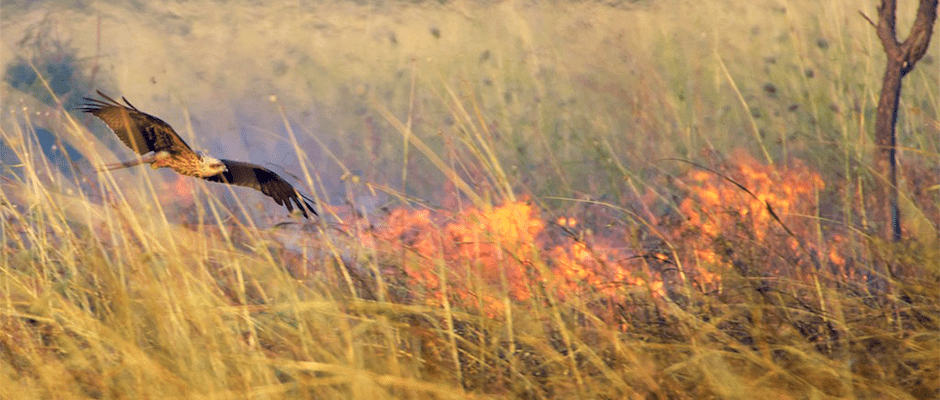Share this article
Australian ‘firehawks’ use fire to catch prey
For thousands of years, Australia’s Aboriginal people have sung stories about sacred “firehawks” — raptors that, according to lore, use fire to hunt and introduced fire to humans. Now, merging traditional knowledge, firefighter reports and other sources, an international research team has validated at least part of these legends. Raptor species in northern Australian savannas really do spread fire to smoke out prey.
“This behavior has been widely seen — raptors flying around fires by the thousands in some cases,” said Mark Bonta, lead author on the paper published in the Journal of Ethnobiology. “They see smoke, and they’re on their way. They’re picking up a brand repeatedly until they’re able to take a fire across a road, river or firebreak created by humans. It’s intentional, as they’re going to fires and doing this because more prey are needed.”
From 2011 to 2017, Bonta — an assistant professor of earth sciences at Pennsylvania State University — and his colleagues interviewed indigenous people, fire rangers, academics and others who had witnessed firehawks carrying fire in the Northern Territory, Queensland and Western Australia. Their observations indicated black kites (Milvus migrans), whistling kites (Haliastur sphenurus) and brown falcons (Falco berigora) congregate around savanna fires, descend to seize burning sticks and transport them in their beaks or talons, either individually or in small cooperative groups. After dropping the sticks in other areas and setting the ground ablaze, these fire specialists swoop closer and grab grasshoppers and other invertebrates in midair as the prey flee the smoldering vegetation.
“Certain birds are fire followers in that they will take advantage of fires,” Bonta said. They perceive smoke and snatch the flushed-out animals. But a few raptors actively disperse flames on the landscape to obtain food. Their reliance on fire challenges the conventional notion that only human beings can wield it, he said, and it casts light on recent research suggesting birds have higher intelligence than was previously thought.
Yet this fire manipulation could put other birds on the savanna in jeopardy, Bonta said. Since European colonization, he said, cattle ranchers have suppressed fire to protect livestock, including by illegally shooting species resembling firehawks — possibly rarer birds like letter-winged kites (Elanus scriptus), square-tailed kites (Lophoictinia isura) and peregrine falcons (Falco peregrinus).
For many Australians, the birds’ use of fire isn’t news. Rangers in northern Australia take these animals’ ability to perpetuate fires into account when managing fuel load in the ecosystem, Bonta said. Modern anthropological records of firehawks distributing flames to capture prey date back to 1963, Bonta said, when a book described raptors snatching brands from indigenous cooking fires and depositing them in grass up to half a kilometer away.
While tales of firehawks have a long history in Aboriginal culture, that knowledge is being lost, he said. “We’re stimulating people to say, ‘Our knowledge is valuable and needs to be rescued and published.’”
This May, he and his collaborators are returning to Australia with binoculars and high-tech cameras to discover more about its firehawks with the help of local land managers who’ll kindle controlled burns and cooking fires to attract them. Bonta intends to gather data on the prevalence of the ranch practice of killing raptors, too. The researchers are also investigating whether people have noticed raptors spreading fire in South America and Africa, and they hope to establish methods for others to study fire foraging.
“It’s a fascinating topic of inquiry,” Bonta said. “Hopefully it’ll open up a lot of people to start looking for it and inspire ornithologists to get out there.”
Header Image: A raptor flies approaches the burning savanna in Australia’s Northern Territory. ©Bob Gosford









